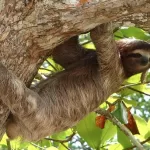Have you heard of the Neddicky or the Nihoa Finch? The northern cardinal and possibly the nightingale are two birds that most people are familiar with. You may learn more about these and other birds in this post because they all have similar traits.
Birds That Start with N – List of Birds Begins with the Letter ‘N’

These stunning birds that begin with “N” will wow you with their beauty, from the Nene, a Hawaiian goose with an interesting past, to the Nicobar pigeon with iridescent plumage. Prepare to astound your pals with your knowledge of these birds whose names begin with “N.”
Nightingale
Luscinia megarhynchos is its scientific name.
A nightingale is a simple bird with a brown and light gray body that can be found in Western Europe, Asia Minor, North Africa, Southern, and East Africa. The Nightingale is well known for its stunning voice.
Due to this, it has been included in legends and even fairytales. In the winter, nightingales go from Europe and Asia to Africa. The nightingale has a greater portion of its brain than other birds, which allows it to make roughly 1000 different sounds.
Nene
Branta sandvicensis is its scientific name.
There were just around 30 Nene remained in the wild when it was proclaimed the official bird of Hawaii in 1957. The population has progressively increased since that time, and there are currently about 2500 birds.
The Nene has a gray body with a white neck that is striped in black. It has a black face. The Nene is the rarest and most endangered of all the geese.
Nankeen Kestrel
Falco cenchroides is its scientific name
The medium-sized bird of prey known as the Nankeen Kestrel can be found in Australia, New Guinea, and Indonesia. The majority of it is white, while the wings and nape of the neck are reddish-brown. Its wings’ tips are black.
On poles or dead trees, these birds are frequently spotted perched. They can hover still for a long period and are graceful in the air. In the eighteenth and nineteenth centuries, the hue “Nankeen” was a favorite for trading.
Neddicky
The species is known as Cisticola fulvicapilla.
A small bird native to central to southern Africa, the neddicky has a reddish-brown head, a brownish back and wings, and white underparts. It has a loud voice.
Neddickies consume a wide range of seeds and tiny grasses in addition to termites, moths, and grasshoppers. After the initial couple of eggs in the batch, the Neddicky can occasionally lay one egg every couple of days.
Northern Saw-Whet Owl
Scientific Name: Aegolius acadicus
The Saw-whet Owl is a little, brown-and-white mottled owl found in North America. A white ‘V’ may be seen between its eyes. The young owl has a cinnamon-colored breast. It is a migratory bird that, throughout the winter, migrates from higher to lower elevations.
Due to the owl’s tendency to remain still when frightened, many people believe them to be domesticated. The Northern Saw-whet Owl’s call can be heard from half a mile distant despite being so little in size.
Northern Royal Albatross
Diomedea sanfordi is the scientific name.
One of the largest birds in the world, the Northern Royal Albatross is found on Taiaroa Head, New Zealand. It has large, black wings that are white underneath. These birds live in colonies where monogamous couples raise the young collectively.
In essence, the Northern Royal Albatross lives alone. The Northern Royal Albatross is gaining more recognition as a result of the webcam installed at Taiaroa Head.
Northern Screamer
Name in science: Chauna chavaria
The Northern Screamer is a very large bird with a black body and wings, red legs, a white face, and a red stripe around the eyes that may be found in Colombia and Venezuela. The white underwing is visible when it is in flight.
It spends the majority of its life on the ground and inhabits marshes. The Northern Screamer gets its name from its characteristically high-pitched yelping cry.
Northern Scrub Robin
Drymodes superciliaris, scientific name
The Northern Scrub Robin has relatively large legs for a small Australian bird. It stands out thanks to its white front and belly, brown rear, and wings with black and white stripes.
Its population is stable and regarded as being of the least conservation-related concern. Southern Scrub The black diagonal stripe that crosses the eye of a robin in a straight line is its most distinguishing characteristic.
Nightjar
Caprimulgus europaeus is its scientific name.
Wales, Southwest Scotland, Northern England, North America, Southern Africa, and South America are all frequent locations for nightjar sightings. It is a medium-sized bird called a nightjar. It is flat-headed, grey-brown in hue, and has a pointed tail. It is a nocturnal bird that hunts by using its large eyes.
They lay their eggs straight on the ground and are found in open meadows. Because of how much of their coloring resembles the bark of trees, nightjars can blend into them during the day.
Nuttall’s Woodpecker
Dryobates nuttallii is its scientific name.
The male Nuttall’s Woodpecker bears the distinctive red crown of many of its relatives, which stands out sharply against its body of black and white specks. This tiny bird pecks into the bark in search of food, exposing it as it goes.
If you live in the restricted area of the Nuttall’s Woodpecker in the state of California, where it is endemic, you can draw it to an urban garden by placing out a suet ball.
Nile Valley Sunbird
Hedydipna metallica is its scientific name.
The Nile Valley Sunbird is a little bird with a shorter bill than most of its relatives. It is found in Northern and Eastern Africa, as well as Saudi Arabia. The male has a long tail, a yellow front, a black head, and a glossy green head.
The female has a shorter tail and is less attractive. The male Nile Valley Sunbird’s tail lengthens by at least two inches (5 cm) during the breeding season.
Narina Trogon
Apaloderma narina is its scientific name.
The Narina Trogon is a medium-sized bird that stands out thanks to its bright red breast and green head. The tail feathers are a blue-green metallic color. The bird is very elusive despite its beautiful colors.
It has a wide range and is found in Sub-Saharan Africa, where it is regarded as being of Least Concern. The Narina Trogon is a worldwide species since its name is a combination of two languages, KhoiKhoi and French.
Nihoa Finch
Name in science: Telespiza ultima
On the island of Nihoa, the Nihoa Finch inhabits a very tiny region and has a very low population. Its conservation status is Endangered because it is sensitive to any climatic changes.
These finches are little birds that stand out for having yellow breasts and heads. On Nihoa Island, which is close to Hawaii, the Nihoa Finch is one of just two endemic bird species.
Northern Goshawk
Accipiter gentilis is its scientific name.
Large raptors, Northern Goshawks are comparable in size to Red-tailed Hawks. Although it may be challenging to locate them, you have the best chance of finding them by taking a calm stroll and paying attention to old forests with big trees. Additionally, they are renowned for ferociously guarding their nests and young, even attacking anyone who approaches too closely.
Adults have a bright stripe over their eyes and a top that is dark slate gray with barred light gray underparts. The northern goshawk breeds and lives in woodlands with tall trees. They eat a variety of food, including other birds, animals, carrion, and insects, and are primarily opportunistic feeders.
Join 25,000+ smart readers—don’t miss out!








